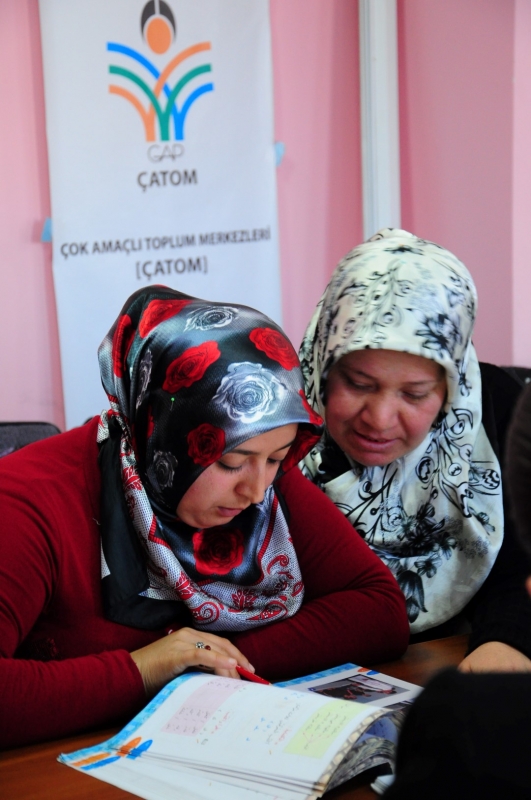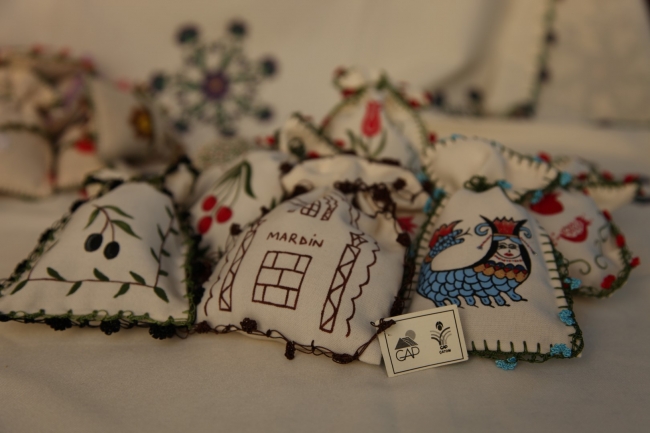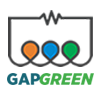 The GAP Administration engaged in a range of projects that integrate the economic, social and environmental dimensions of sustainable development through strategies for poverty alleviation and that focus on participatory approaches and capacity building for disadvantage groups from a gender perspective. The project for Multi-Purpose Community Centres (ÇATOMs) is one of the most significant among these projects. ÇATOMs derived from the Social Action Plan that the Administration developed on the basis of the findings of 5 baseline survey conducted during the period 1992-1994 as well as on the findings of the survey “Status of Women in the GAP Region and their Integration to the Process of Development.”
The GAP Administration engaged in a range of projects that integrate the economic, social and environmental dimensions of sustainable development through strategies for poverty alleviation and that focus on participatory approaches and capacity building for disadvantage groups from a gender perspective. The project for Multi-Purpose Community Centres (ÇATOMs) is one of the most significant among these projects. ÇATOMs derived from the Social Action Plan that the Administration developed on the basis of the findings of 5 baseline survey conducted during the period 1992-1994 as well as on the findings of the survey “Status of Women in the GAP Region and their Integration to the Process of Development.”
Multi-Purpose Community Centres (ÇATOMs) were first launched in 1995 in the region and at present there are 48 ÇATOMs active in 9 provinces. The target population of these centres consist of women and young girls. Also, in coorperation with Governor of Kilis, Azez ÇATOM was established in Azez District of Syria in 2018 and Azez ÇATOM has still been continuing its activities.
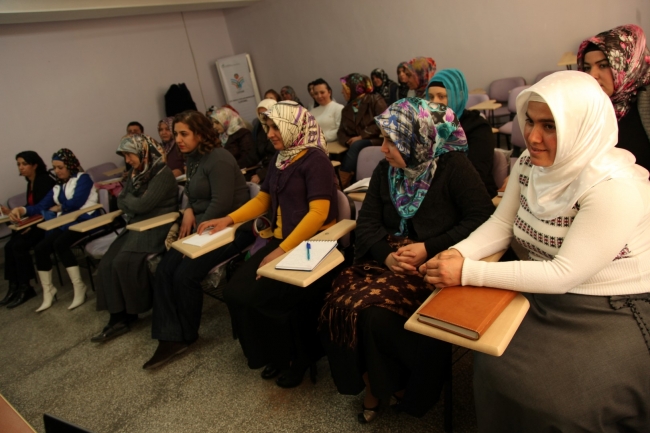
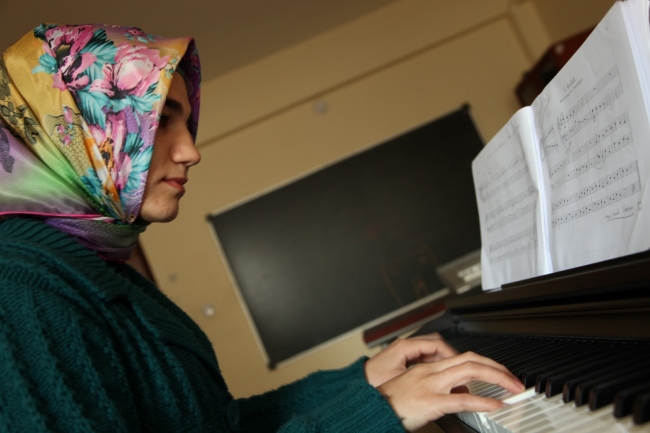
Presently active ÇATOMs:
| No | ÇATOMs | Adress |
|---|---|---|
| 1 | Adıyaman | Fatih neighbourhood, Gerger and Gölbaşı districts |
| 2 | Batman | Petrolkent neighbourhood, Yavuzselim and Yeşiltepe neighbourhoods, Sason distirict |
| 3 | Diyarbakır | Ziya Gökalp, Huzurevleri, 5 Nisan and Fatihpaşa neighbourhoods, Silvan, Çermik, Ergani districts |
| 4 | Gaziantep | Central and Nurdağı district |
| 5 | Kilis | İslambey and Mehmet Saraç districts, Azez region of Syria. |
| 6 | Mardin | Meydanbaşı, Medrese-Gül , Latifiye districts, Dargeçit, Kızıltepe, Midyat, Mazıdağı Nusaybin, Savur and Ömerli Counties. |
| 7 | Siirt | Central, Kurtalan and Şirvan districts, and Kurtalan-Kayabağlar |
| 8 | Şanlıurfa | Central (Ahmet Yesevi and Parmaksız), Bozova, Viranşehir, Hilvan, Ceylanpınar, Siverek, Birecik and Suruç districts |
| 9 | Şırnak | Central, Cizre, Beytüşşebap, Silopi, İdil and Uludere districts |
Objective
ÇATOMs are community based and participatory centres established at the neighbourhoods of cities mostly inhabited by rural migrants, district centres and centrally located villages. Inhabitants of these neighbourhoods are mostly persons working informally in marginal, temporary, seasonal and precarious jobs for minimal wages/incomes. Children also have to work to support their families. Research carried out so far point out that women and children are adversely affected by poverty. Any improvement in the social and economic status of women directly finds its reflection on the level of family welfare. Therefore, besides being a must in terms of human rights, projects designed to improve the status of women contribute significantly to social welfare as well.
The objectives of ÇATOMs are as follows:
- Creating opportunities for women to become aware of their problems and launch initiatives for their solution;
- Ensuring that women take part in public sphere and benefit more from available services;
- Enhancing female employment and entrepreneurship;
- Contributing to equal opportunities by empowering women;
- Starting the process of gender balanced development and developing replicable models relevant to local circumstances for participatory community development.
The basic principle observed in ÇATOMs is not to tell women what to do but demonstrating what can be done under different circumstances. Attending women should decide on their own which to select among available alternatives.
Management and Approach
In the establishment and management of ÇATOMs, local requests are observed and cooperation is made with local lines of the Government while technical assistance is provided by the Development Foundation of Turkey (TKV). In addition to community participation, inter-organisational cooperation is also emphasised and efforts are made to expand cooperation and launch joint projects with local, national and international organisations. The aim is to develop a healthy dialogue between the neediest sections of population and governmental/civil society organisations and to lay the foundations of a human-centred peaceful and democratic society.
ÇATOMs are managed by ÇATOM Committees elected from among ÇATOM participants. These committees are composed of 5 to 7 members including a trainer who is also elected by ÇATOM managers and participants. Inclusion of participants in management committees has the aim of building management capacity in local women. ÇATOM members in groups make visit to houses to build strong neighbourhood relations and to identify the priorities and needs of households. In determining specific ÇATOM programmes, local circumstances and needs as well as local participation are taken as basis. An integrated and flexible approach is adopted and ÇATOM participants are encouraged to take part in all running programmes. In the course of time and along with developments taking place, children were also included in ÇATOM programmes with the launching of pre-school education programmes and children’s reading rooms. Adult males can also be covered, though partly, in some programmes including computer operation and literacy. Social support programmes and cultural/social activities are deigned to cover all household members.
“During our visits to homes, the presence of ÇATOM leader, direct interview with household heads and ÇATOM leaders’ involvement in promoting ÇATOM to their relatives and neighbours further enhanced participation. The ÇATOM leadership brought together participants when there was any order and made a division of work, which contributed to productivity.” Şanlıurfa Yakubiye ÇATOM
“The ÇATOM Leadership asked for a lawyer from Siirt Bar to come and inform the audience about women’s rights and the new Turkish Civil Code. The ÇATOM organised the meeting and ensured participation.” Siirt Kurtalan ÇATOM
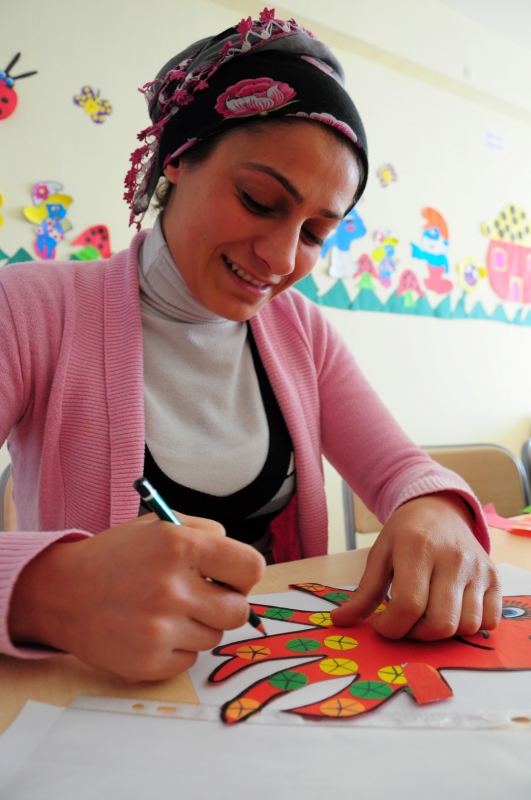
ÇATOM Programmes
Programmes implemented under ÇATOMs can be given under 7 main headings as follows:
- Training Programmes: Programmes in literacy training, civil code and legal rights, home economics, nutrition, maternal training, computer skills, student support, etc.
- Health Programmes: Training programmes in hygiene, environmental cleanliness, maternal and child health and public health; partial policlinic and mobile health services; health work in neighbourhoods and rural settlements; health screening, immunisation campaigns, etc.
- Programmes for Income Generation and Promoting Female Employment/Entrepreneurship: i) Training programmes for building occupational and income generating skills (handicrafts, machine knitting, cutting-sewing, furniture, felt processing, stone works, silversmith works, textiles, toys, souvenirs, soap making, cloth dyeing, hair dressing, cooking, etc.); ii) training activities and other services to encourage entrepreneurship including micro-financing and business counselling; iii) marketing support (exhibitions and fairs). A product catalogue was developed for on-line promotion and marketing of ÇATOM products.
- Pre-school Training Programmes: Courses covering children in the age group 4-6.
- Children’s Reading Rooms: Group, pre-school and “open door” programmes targeting children in age groups 4-6 and 7-14.
- Social Support Programmes: Provision of support in such issues as birth registration, civil marriage, green card, etc; referring girls in particular to YİBOs (regional primary boarding schools) and open education; mediating for granting scholarships to children from poor families including girls in the first place; cash and in-kind assistance to needy households; provision of wheelchair to disabled persons, etc.
- Programmes for Social Responsibility: Campaigns for supporting school enrolment; village or neighbourhood-based activities, environmental protection and reforestation, health screening, immunisation campaigns, volunteer support to social work, etc.
- Cultural and Social Activities: Seminars, exhibition, interactive meetings, visiting theatres and movie houses, celebration of special days, drama, excursions and picnics.
“As members of ÇATOM field volunteers, our work enabled us to know our working area better. We learned many things including how families struggled hard for subsistence, disadvantaged groups, problems faced by young girls and many other things that I hesitate to mention. I came to realise how distant I had been from the realities of my own environments. Not only this, I witness many other things as well through ÇATOM activities. For example, I didn’t know before that March 8th was my day as a woman. I learned this thanks to ÇATOM and I celebrated that day together with other women.” Mardin Ömerli ÇATOM Participant
“We can observe that local women move towards a level of awareness on women’s human rights and fundamental freedoms through training in legal and civil rights. It was also observed that ÇATOMs are right places for this training since attending women feel themselves safe at these centres and express themselves freely.” Trainer-Lawyer
"When we visited Şanlıurfa Institution for elderly people, our uncles and grandparents were happy to see us. Our presents helped them forget some of our daily problems and loneliness at least for few hours.” Şanlıurfa Yakubiye ÇATOM
Best Practice: The ÇATOM project was one of the 23 projects presented by the Government of Turkey to the Rio + 10 Sustainable Development Summit held in Johannesburg in September 2002. The ÇATOM project further made it to the first 150 out of 870 projects evaluated in the context of “Water Action Contest” during the 3rd World Water Forum in Kyoto, Japan (16-23 March 2003).

ÇATOM Contribution to Income Generation and Employment
ÇATOMs are centres where women are empowered in economic and social terms. Each ÇATOM is a space specially developed for women and this space is being used for training, income generating activities and organisation of participating women. ÇATOMs are important centres not only in social areas including female literacy, improvements in health indicators and building information in legal rights, etc., but also for encouraging women to participate in labour force. ÇATOM women taking part in an income generating activity may also follow other programmes and, what is more important, communicate among and learn from each other. In this sense, ÇATOMs are also learning centres. Since ÇATOM still remains there when a cohort of participants completes their courses, their information and skills can be renewed, updated through informal networks and sustained. Women and young girls earn by producing either at ÇATOMs or their homes or find jobs in various places including boarding schools, textile workshops, hair dresses, department stores, childcare services, etc. Training and micro financing facilities for those with entrepreneurial skills help them start their own business. Especially for the last two or three years, each year about 500 females on average find jobs and 40-50 women start their businesses. An increase in the number of ÇATOMs will therefore mean more females employed or running their own workplaces.
Felt processed at international standards with the technical support from the Anatolian Artisans Foundation have a good marketing advantage and an order amounting to 12,500 US$ was responded to by ÇATOM participants.
Some Major Achievements
- ÇATOMs reached the poorest and most disadvantaged population groups and contributed to social justice. They acted as facilitators and intermediaries in directing the poor to available social services, which eventually ended up in the development of participatory community development models.
- Based on local community participation and organisational partnerships, the ÇATOM Model with its multiplier effect presented a justifiable ground for other projects focusing on participatory local development.
- ÇATOMs helped gender problems and women become more visible. ÇATOMs and their activities contributed to the emergence of an understanding and awareness that women’s inclusion in development projects is a must in terms of human rights and a factor which strengthens economic and social development.

